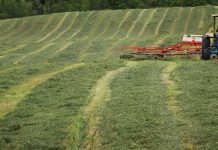The Dairy Excel 15 Measures of Dairy Farm Competitiveness bulletin was published by Ohio State University Extension to provide dairy farmers the ability to evaluate business competitiveness using financial and production information. Measure 11, Debt to Asset Ratio — Debt per Cow, is discussed in this article. Solvency, as measured by the debt to asset ratio, was discussed in a previous column.
Another way of looking at the ability of a dairy farm to meet its debt obligations is by looking at the total level of debt per cow. While the debt to asset ratio measures the overall debt position of the business, debt per cow relates to how a manager would repay the debt. As the profit center of a dairy operation, cows generate the money needed to make both the principal and interest payments.
Debt too high
When a business has debt per cow levels significantly higher than $3,300, it may have trouble meeting all principal and interest payments. Solutions to this problem could include the following:
1. Selling any unproductive assets and paying down debt
2. Increasing the number of cows with little additional debt
3. Increasing net income per cow and paying down debt
4. Withdrawing less from the farm business for family living and paying down debt if family withdrawals were unreasonably high.
Debt too low
If a business has a very low debt per cow and is not highly profitable, the management team should carefully assess the operation and consider if moderate investments could increase efficiency and profitability.
Planning tool
A manager can quickly estimate the amount of additional debt possible to take on to finance an expansion and stay around $4,300 debt per cow. Further profitability and cash flow analyses must be done to verify that the business can profitably operate at this level of debt and reduce total debt per cow following the expansion.
For example, Cliff Farms Dairy currently has 200 cows, milking and dry, with a debt load of $2,800 debt per cow. The dairy plans to expand to 500 cows and wants to keep total debt less than $4,300 per cow.
Original 200 cows x ($4,300 – $2, 800) $300,000 (Additional debt for existing cows) Additional 300 cows x $4,300 $1,290,000 (Debt for new cows) Total maximum new debt $1,590,000
This calculation does not indicate if the dairy could expand profitably and pay back principal and interest at this level of debt. Further cash flow projections must be completed and stress-tested before a final decision is made.
Summary
Knowing your debt per cow is critical for making day-to-day management decisions on your farm, especially when evaluating whether to assume additional debt.
Talk to your lender and/or OSU extension educator to discuss your present financial position and ways to improve financial solvency. See the OSU Extension Dairy Excel’s 15 Measures of Dairy Farm Competitiveness at dairy.osu.edu. Additional information about farm financial management is available at farmprofitability.osu.edu/ and u.osu.edu/ohioagmanager/.













